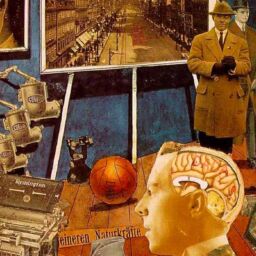
Migrating Identities
The Perceiving Functions and Cultural Adaptation
Abby Chow and Debbie Clelland, October 4, 2017

With a view to deepening practitioners’ understanding of the processes that may be experienced by acculturating clients, the authors conducted a study to find the relationship between personality type and identity integration in acculturation. This study employs Jungian personality theory to investigate how each theoretical model reflects and impacts actual people who are facing the challenges of acculturation. In this article, the term “practitioners” includes all helping professionals who help acculturating clients better adjust to their new cultural environment. We conducted this study because the research so far does not give a clear idea of how to help clients through the acculturation process. We found that understanding individual differences in personality as they relate to identity integration can contribute to the therapeutic process for practitioners working with the acculturating population.
Current models for working therapeutically with acculturating persons, such as the Cross-Cultural Assessment Model, emphasize the importance of cultural context, the individual’s life phase, life stage, and personality style (Dieser, 2014). However, studies of individual differences and their contribution to the process of acculturation (e.g., Sam & Berry, 2010; Yoon et al., 2013) have provided inconclusive results due to the complex nature of personality and acculturation, both in concept and in the measurements that assess them (Sam & Berry, 2010; Zane & Mac, 2003). For example, acculturation has been assessed with measures that use behavioral, value, and identity indicators (Sam & Berry, 2010), while personality has been assessed with measures that use the Big Five trait approach and cognitive processes such as locus of control as indicators (Yoon et al., 2013). In other words, personality styles have commonly been assessed on the basis of behavioral tendencies. For example, Dieser (2014) proposed questions that examine the activities, environments, and interests chosen, and the preferred way of socializing as well as the preferred process of decision-making. When asking questions about decision-making, Dieser referred to the speed of and caution used for decision-making.
While these questions are valid, we decided to focus on personality types rather than personality traits to study the role of identity integration in the acculturation process. Specifically, we found it important to consider the perceiving functions in understanding individual differences in acculturation: That is, how do acculturating individuals process the new information they encounter in a new environment? To address this question, we consulted personality type theory as measured by the Majors Personality Type Inventory (MajorsPTI), and the Cognitive Developmental Model of Social Identity Integration (CDMSII; Amiot, de la Sabionnière, Terry, & Smith, 2007) as measured by the Multicultural Identity Integration Scale (MULTIIS; Yampolsky, Amiot, & de le Sabionnière, 2016). Due to the small sample size of the study, n=60, we restricted the analysis to the eight preferences within the four dichotomies of Jungian personality type, as opposed to analyzing the eight functions (Chow, 2017).

Anticipatory categorization is a self-anchoring process that occurs when the acculturating person expects that change will occur (Amiot et al., 2007). In this process, individuals prepare for change by anticipating the similarities between themselves and the new cultural group (Amiot et al., 2007). When acculturating persons actually experience the new cultural group, this process is replaced by the experience of distinctive differences between themselves and this cultural group (Amiot et al., 2007). This is the cognitive process associated with the categorization stage. In this stage, the acculturating persons may begin to identify more exclusively with their heritage culture, seeing the new culture as a culture fundamentally conflicting with their own (Amiot et al., 2007). Through continual contact with the new cultural group, the acculturating persons begin to recognize that they also hold similarities with the new group and begin the cognitive processes associated with the compartmentalization stage (Amiot et al., 2007).

The purpose of the study was to determine if there is a relationship present between Jungian personality type and the process of identity integration in first-generation, acculturating persons who have immigrated to Canada from non-western cultures. Participants were individuals who have immigrated to Canada as citizens, permanent residents, or temporary residents (n = 60; Chow, 2017). The focus on non-western cultures follows an important historical pattern of immigration from non-western to western cultural areas of the world (Schwartz, Unger, Zamboanga, & Szapocznick, 2010). To assess the stages of the CDMSII, we employed the MULTIIS (Yampolsky et al., 2016), which was designed to measure all stages of the CDMSII with the exception of the anticipatory categorization stage. The anticipatory categorization stage was excluded because the scale was developed with a population that has already been in contact with mainstream culture (Yampolsky et al., 2016). To adapt the MULTIIS to study bidimensional analysis, we duplicated the MULTIIS categorization scale to create a categorization to mainstream culture scale and a categorization to heritage culture scale, as instructed by M. A. Yampolsky (personal communication, June 30, 2016; Chow, 2017). We then correlated these scales with the results for extraversion, introversion, intuition, sensing, thinking, feeling, judging, and perceiving as measured by the MajorsPTI (Chow, 2017).
When correlating the stages, or identity configurations, of the adapted MULTIIS––categorization to mainstream, categorization to heritage, compartmentalization, and integration––with personality type preference results from the MajorsPTI, we found a significant correlation (p = 0.05) between the integration scale of the MULTIIS and the sensing-intuition dichotomy. Specifically, a preference for intuition, as opposed to a preference for sensing, accounts for 25% of the variance in scores of the integration scale of the MULTIIS (Chow, 2017). In light of these results, it may be that the processes of identity integration particularly draw on the function of intuition. An implication that merits further consideration is that those who prefer intuition tend to find the use of intuition easier, and may therefore find the process of integration an easier one. With intuition defined as a perceiving function that is strongly based in abstractions, possibilities, and relationships (Briggs-Myers, McCaulley, Quenk, & Hammer, 1998), it is possible that the nature of intuition is more aligned with the cognitive resources needed for integration (Briggs-Myers et al., 1998; Chow, 2017).


Perhaps the most salient difference between those who prefer intuition versus those who prefer sensing is their respective approach to change (Barger & Kirby, 2004; Geyer, 1995; Jessup, 2002; Kummerow & Quenk, 2003; Pearman, 1999; Quenk, Hammer, & Majors, 2001). A preference for intuition tends to be associated with an intrinsic valuing of change—“change for change’s sake.” For intuitives, change can be a thrilling undertaking. Contrasting this perspective is the sensing type’s preference for practicality. A preference for sensing tends to be associated with a step-by-step process to change that is anchored in what is known, as well as what is necessary and practical. If acculturation is viewed as a process of change, the positive orientation of intuition towards change may suggest that intuitive individuals possess a greater propensity for reconciling different cultural identities. This is not to say that those with a preference for sensing are unable to reconcile different cultural identities. Given that all individuals are able to use all functions, it is possible that those with a preference for sensing simply need to be presented with a practical reason to undertake the reconciliation of cultural identities. Although further research is needed to establish the validity of these findings, it does give some insight into how practitioners may be able to use personality type and, in particular, the sensing-intuition dichotomy to better support the acculturating population.

Future research may provide more insight into these questions of how a preference for sensing may influence the avenue for identity integration in acculturating persons and to working with the acculturating population. Practitioners must be aware of other factors that affect the acculturation process, beyond a preference for sensing or intuition, such as systemic oppression, perceived discrimination, and language barriers. Practitioners should be aware that acculturative distress may stem not only from struggles associated with identifying with mainstream culture but also from a possible devaluation of acculturating persons’ heritage culture when integrating a new cultural identity into their self-concept (de la Sabionnière et al., 2016). Additionally, although the integration identity configuration has been demonstrated to be more likely associated with well-being (Amiot et al., 2007; Yampolksy et al., 2013, 2016), individual differences exist, and one identity configuration should not be recommended over another (Yampolsky et al., 2013). That is, other identity configurations may not be accessible or possible when considering the societal environment (de la Sabionnière et al., 2016; Taylor & Kachanoff, 2015).
Our study suggests that helping clients understand how they process information may open up possible interventions that further the adaptation process. This understanding could be particularly influential if clients are experiencing stress from the acculturation process. For example, Kendall (1996) found that there were substantial differences between the sixteen types and their needs in the acculturation process. In consolidating these patterns, she stressed the importance of further understanding to address individual concerns in a more client-oriented manner (Kendall, 1996). Additionally, the clients’ level of agency in the acculturation process may affect their level of adaptation, regardless of the configuration that is currently in use (Yampolsky et al., 2013). Thus, helping clients consciously work through their process of identity integration may assist them in recognizing a greater level of agency throughout the process and facilitate the recognition of greater success in adaptation.



There exists a pressing need for a more complete understanding of how individual differences affect identity integration, as well as the wider acculturation process. In view of the marked and rapid expansion of transnational living and immigration, the pressure for cultural adaptation will only continue to grow. Consequently, the probability that practitioners will be working with individuals who are feeling distressed by the acculturation process will also increase. The findings of the present study suggest that understanding the relationship between the perceiving functions and identity integration, and applying that understanding, may also make an important contribution.
References
Amiot, C. E., de la Sabionnière, R., Terry, D. J., & Smith, J. R. (2007). Integration of social identities in the self: Toward a cognitive-developmental model. Personality and Social Psychology Review, 11(4), 364–388. https://doi.org/10.1177/1088868307304091
Barger, N. J., & Kirby, L. K. (2004). Introduction to Type® and change. Palatine, IL: CPP.
Berry, J. W., Phinney, J. S., Sam, D. L., & Vedder, P. (2006). Immigrant youth: Acculturation, identity and adaptation. Applied Psychology, 55, 303–332. https://doi.org/10.1177/0022022102033005005
Briggs-Myers, I., McCaulley, M. H., Quenk, N. L., & Hammer, A. L. (1998). MBTI manual: A guide to the development and use of the Myers-Briggs Type Indicator (3rd ed.). Mountain View, CA: CPP.
Chow, A. T. Y. (2017). The relationship between Jungian personality type and the process of identity integration in acculturation. Unpublished master’s thesis. Adler University, Vancouver, Canada.
de la Sabionnière, R., Amiot, C. E., Cárdenas, D., Sadykova, N., Gorborukova, G. L., & Huberdeau, M. (2016). Testing the subtractive pattern of cultural identification. European Journal of Social Psychology, 46, 441–454. https://doi.org/10.1002/ejsp.2178
Dieser, R. B. (2014). Cross-cultural assessment in therapeutic recreation. Therapeutic Recreation Journal, 48(1), 1–14. Retrieved from http://js .sagamorepub.com/trj/article/view/4746
Dunn, B. R. (1985). The relationship between personality type and memory processes. Journal of Psychological Type, 9, 30–33. Retrieved from https://www.capt.org/jpt/pdfFiles/Dunn_B_Vol_9_30_33.pdf
Gadd, C. J. (1971). Code of Hammurabi. In W. E. Preece (Ed.), Encyclopaedia britannica. 11 (pp. 41–43). Chicago, IL: William Benton.
Geyer, P. (1995, April). How different people approach change. Management.14–15. Retrieved from https://capt.booksys.net/opac/ibml/GetMedia?type=bib&mediaID=7779
Holsworth, T. E. (1985). Perceptual style correlates for the MBTI. Journal of Psychological Type, 10, 32–35. Retrieved from https://www.capt.org/jpt/pdfFiles/Holsworth_T_Vol_10_32_35.pdf
Jessup, C. M. (2002). Applying psychological type and “gifts differing” to organizational change. Journal of Organizational Change Management, 15(5), 502–511. https://doi.org/10.1108/09534810210440405
Kendall, J. (1996). The relevance of the MBTI in moving between cultures. Fourth International Type User’s Conference (pp. 69-72). Sandton, South Africa. Retrieved from https://capt.booksys.net/opac/ibml/GetMedia?type=bib&mediaID=8291
Kummerow, J. M., & Quenk, N. L. (2003). Understanding your MBTI step II results. Palo Alto, CA: CPP.
Leonard, N. H., Scholl, R. W., & Kowalski, K. B. (1999). Information processing style and decision making. Journal of Organizational Behavior, 407–420. https://doi.org/10.1002/(SICI)1099-1379(199905)20:3<407::AID-JOB891>3.0.CO;2-3
Majors, M. (2015). Majors PTI: The Majors Personality Type Inventory professional user manual. Norwood, MO: Handbook Press.
Markus, H. & Wurf, E. (1987). The dynamic self-concept: A social psychological perspective. Annual Review of Psychology, 38(1), 299–337. Retrieved from http://www.annualreviews.org/doi/abs/10.1146/ annurev.ps.38.020187.001503
Myers, I. B., Kirby, L. K., & Myers, K. D. (1998). Introduction to type: A guide to understanding your results on the Myers Briggs Type Indicator (6th ed.). Palo Alto, CA: Consulting Psychologists Press.
Onorato, R. S., & Turner, J. C. (2001). The “I,” the “me,” and the “us”: The psychological group and self-concept maintenance and change. In C. Sedikides & M. B. Brewer (Eds.), Individual self, relational self, collective self (pp. 147–170). Philadelphia, PA: Psychology Press.
Onorato, R. S., & Turner, J. C. (2004). Fluidity in the self-concept: The shift from personal to social identity. European Journal of Social Identity, 34, 257–278.
Pearman, R. R. (1999). Enhancing leadership effectiveness through psychological type. Gainesville, FL: CAPT.
Quenk, N. L., Hammer, A., & Majors, M. (2001). MBTI® step II manual: Exploring the next level of type with the Myers-Briggs Type Indicator form Q. Palo Alto, CA: CPP.
Sam, D. L., & Berry, J. W. (2010). Acculturation: When individuals and groups of different cultural backgrounds meet. Perspectives on Psychological Science, 5(4), 472–481. https://doi.org/10.1177/1745691610373075
Schwartz, S. J., Unger, J. B., Zamboanga, B. L., & Szapocznick, J. (2010). Rethinking the concept of acculturation: Implications for theory and research. American Psychologist, 65(4), 237–251. https://doi.org/10.1037/a0019330
Taylor, D. M., & Kachanoff, F. J. (2015). Managing cultural diversity without a clearly defined cultural identity: The ultimate challenge. Peace and Conflict: Journal of Peace Psychology, 21(4), 546. http://dx.doi.org /10.1037/pac0000131546
Yampolsky, M. A., Amiot, C. E., & de la Sabionnière, R. (2013). Multicultural identity integration and well-being: A qualitative exploration of variations in narrative coherence and multicultural identifications. Frontiers in Psychology, 4, 1–15. https://doi.org /10.3389/fpsyg.2013.00126
Yoon, E., Chang, C., Kim, S., Clawson, A., Cleary, S. E., Hansen, M., Bruner, J. P., Chan, T. K., & Gomes, A. M. (2013). A meta-analysis of acculturation/enculturation and mental health. Journal of Counselling Psychology, 60(1), 15–30. https://doi.org/10.1037/a0030652/p>
Zane, N., & Mac, W. (2003). Major approaches to the measurement of acculturation among ethnic minority populations: A content analysis and an alternative empirical strategy. In K. M. Chun, P. B. Organista, & G. Marin (Eds.), Acculturation: Advances in theory, measurement and applied research (pp. 39–60). Washington, DC: American Psychological Association.
Images
De Souza-Cardoso, A. (1917). Entrada. Retrieved from wikimedia.org
Dégas, E. (1898). Three dancers. Retrieved from wikiart.org
Gauguin, P. (1892). Landscape with peacocks. Retrieved from wikiart.org
Gris, J. (1926). The reader. Retrieved from wikiart.org
Léger, F. (1919). Men in the city. Retrieved from wikiart.org
Marc, F. (1911). The steer (the bull). Retrieved from wikiart.org
Matisse, H. (1909). Woman in green with a carnation. Retrieved from wikiart.org
Munch, E. (1915). Children in the street. Retrieved from wikiart.org
Picasso, P. (1921). Reading. Retrieved from wikiart.org
Van Gogh, V. (1888). Still life: Vase with fifteen sunflowers. Retrieved from wikiart.org



















Thanks for a great article by Abby Chow and Debbie Clelland. Great research, insights, and observations. The only thing I would push back on is that iNuitives are initially open to change if it’s moving the organization around to a new vision,a new way of doing things. But put an inTuitive in a mass of complicated process changes and see them flee quickly. We confuse minutia and detail for being “out in the weeds.” It’s boring. I want to push a button, have my password entered automatically, and dash on to the kind of change I’m comfortable with at 50,000 ft.